Lesath, Upsilon Scorpii (υ Sco), is a hot blue subgiant star located approximately 580 light-years away in the constellation Scorpius. With an apparent magnitude of 2.70, it is the eighth brightest star in the constellation. It forms a visual pair with the brighter Shaula (Lambda Scorpii). The two stars are sometimes known as the Cat’s Eyes. They mark the stinger of the celestial Scorpion.
Star type
Lesath is a blue subgiant of the spectral type B2 IV. It has a mass of 11.4 solar masses and a radius 6.1 times that of the Sun. With a surface temperature of 22,831 K, it is 7,381 times more luminous than the Sun. A good portion of the star’s energy output is in the ultraviolet band.
Even though it is a young star, with an estimated age of only 20 million years, Lesath has evolved quickly because of its high mass. When it reaches the end of its life cycle, it will go out as a brilliant supernova.
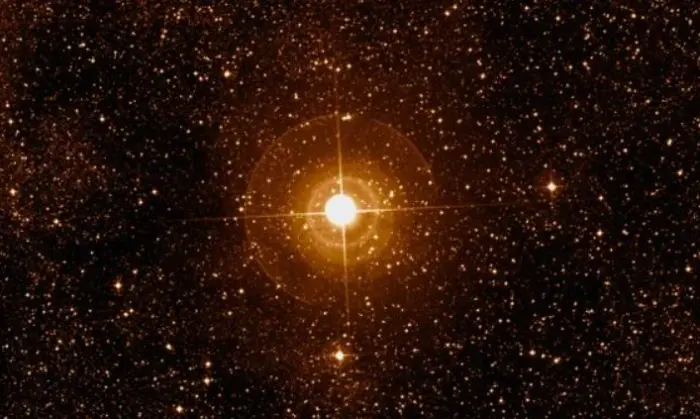
Lesath (Upsilon Scorpii), image: Wikisky
Facts
Lesath is part of the Scorpius-Centaurus association, the nearest OB association to the Sun. Many bright Scorpius stars are also members of the group, including Antares and Shaula, as well as most of the stars of the Southern Cross. Association members are hot, blue O- and B-type stars with estimated ages from 11 to 15 million years. The Sco-Cen (Sco OB2) association has several subgroups and its members are not gravitationally bound.
Even though it is only the eighth brightest star in Scorpius, Lesath is fairly bright at magnitude 2.70. It forms the stinger of the Scorpion with its brighter neighbour Shaula. The stars once shared the name Shaula (meaning “stinger”), but it now formally applies only to Lambda Scorpii. Shaula is a full magnitude brighter than Lesath and part of the Fish Hook, a familiar asterism formed by Antares, Sargas, Larawag and several other bright stars in Scorpius.
Lesath and Shaula are just a line-of-sight pair. Both stars are members of the Scorpius-Centaurus association, but they are not physically related. Shaula is also a blue subgiant star. It has a mass 10.4 times that of the Sun and a luminosity of 36,300 Suns. The star is part of a triple star system located 570 light-years away.
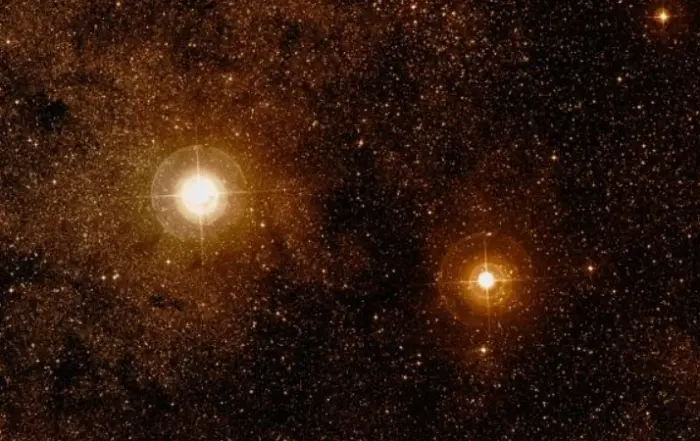
Scorpion’s stinger: Shaula and Lesath, image: Wikisky
Lesath and Shaula were a familiar sight to observers in ancient times. They were listed as dSharur4 u dShargaz (Sharur and Shargaz) in the MUL.APIN, a Babylonian astronomical compendium compiled around 1000 BCE.
The Copts in Egypt called the stars Minamref, while the Boorong people of northwestern Victoria in Australia knew them as Karik Karik (the Falcons).
Name
The traditional name Lesath (pronunciation: /ˈliːsæθ/) comes from the Arabic las’a or Al Las’ah, meaning “pass (or bite) of a poisonous animal.” It was historically also spelled Leschath and Lesuth. The name is a corruption of a Greek word meaning “foggy.” It was approved by the International Astronomical Union’s (IAU) Working Group on Star Names (WGSN) on August 21, 2016.
In Chinese astronomy, Lesath was known as 尾宿九 (Wěi Xiù jiǔ), the Ninth Star of Tail. It was part of the Tail asterism in the larger Tail mansion, which represented the tail of the Azure Dragon. The asterism was also formed by Xamidimura (Mu1 Scorpii), Larawag (Epsilon Scorpii), Zeta1 Scorpii, Zeta2 Scorpii, Eta Scorpii, Sargas (Theta Scorpii), Iota1 Scorpii, Iota2 Scorpii, Kappa Scorpii, and Shaula (Lambda Scorpii). In western astronomy, these stars form the Fish Hook asterism with Antares (Alpha Scorpii), Paikauhale (Tau Scorpii), and Alniyat (Sigma Scorpii).
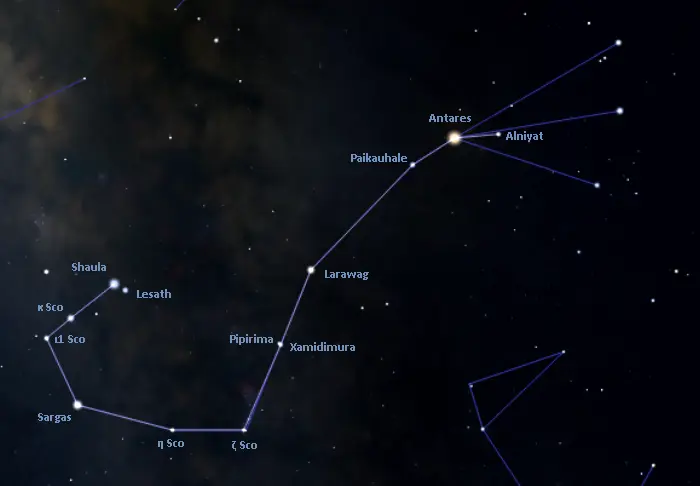
The stars of the Fish Hook, image: Stellarium
Location
Lesath is easy to find because it is part of the recognizable constellation figure of Scorpius. It marks the celestial Scorpion’s stinger with its brighter neighbour Shaula (Lambda Scorpii). The body and tail of the Scorpion are outlined by an asterism known as the Fish Hook. Shaula, the second-brightest star in Scorpius, marks the end of the hook and Lesath appears just next to it. The stars appear near the Teapot, an asterism formed by the brightest stars in the neighbouring constellation Sagittarius.
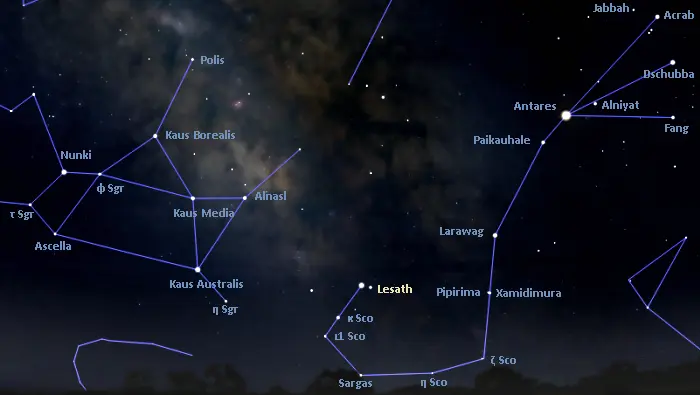
The location of Lesath (Upsilon Scorpii), image: Wikisky
Shaula and Lesath can be used to find several well-known deep sky objects in Scorpius. The bright Butterfly Cluster (Messier 6) appears 5 degrees north and 1.5 degrees east of Shaula. The even brighter and larger Ptolemy Cluster (Messier 7) can be found 4.75 degrees northeast of the star.
The Lobster Nebula (the War and Peace Nebula, NGC 6357), the Cat’s Paw Nebula (NGC 6334), the open cluster NGC 6383, and the globular cluster NGC 6441 also appear in the region of the Scorpion’s stinger.
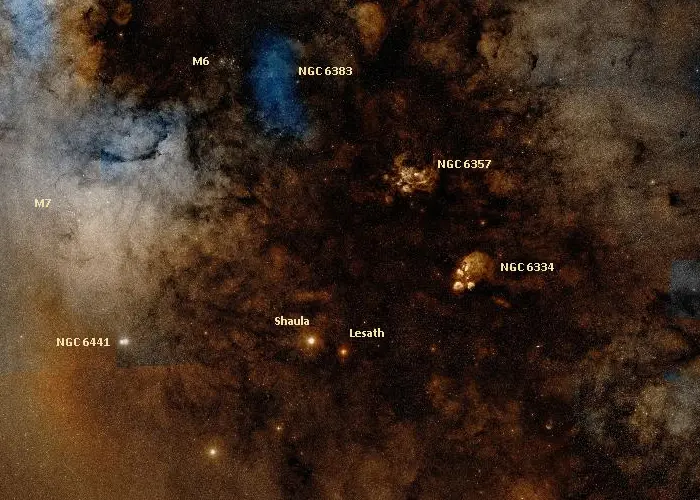
Shaula, Lesath, Messier 6, Messier 7, Cat’s Paw Nebula, War and Peace Nebula, NGC 6441 and NGC 6383, image credit: Wikisky
While Scorpius is visible from the mid-northern latitudes, it is best seen from the southern hemisphere, where it rises high above the horizon. For northern observers, the constellations appears above the southern horizon in the summer months.
Constellation
Lesath is located in the constellation Scorpius. Representing the celestial Scorpion, the zodiac constellation occupies an area of 497 square degrees of the southern sky next to the rich band of the Milky Way galaxy. It is the 33rd largest of the 88 constellations.
Scorpius is one of the easiest constellations to identify because its constellation figure looks like the animal it represents. The Fish Hook asterism – a curving line of bright stars – outlines most of the Scorpion’s body, with the stars Shaula and Lesath marking the stinger. The claws are marked by the relatively bright Acrab, Dschubba and Fang. Antares, the 15th brightest star in the sky, marks the Scorpion’s heart.
Scorpius was one of the 48 constellations catalogued by the Greco-Roman astronomer Ptolemy of Alexandria in his Almagest in the 2nd century CE. In Greek mythology, it represents the scorpion that stung Orion. Like all zodiac constellations, Scorpius lies on the ecliptic, the Sun’s apparent path across the sky, and is invisible for about a month when the Sun appears to pass through it.
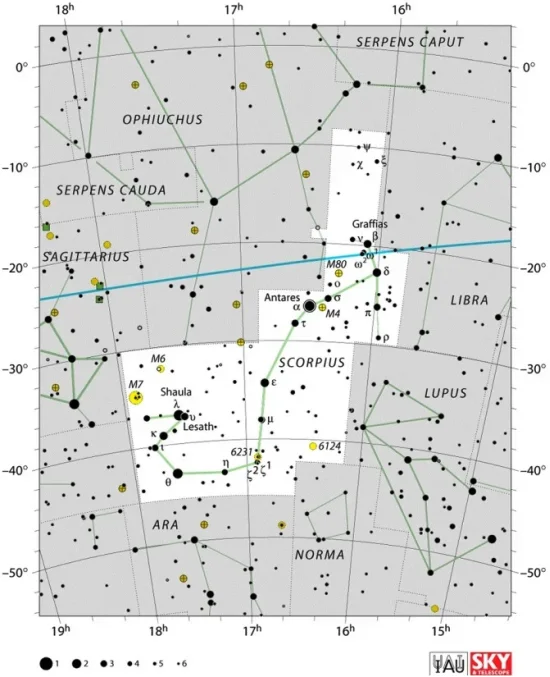
Scorpius constellation map by IAU and Sky&Telescope magazine
Scorpius is best-known for hosting the red supergiant Antares, one of the brightest stars in the sky, and several relatively bright star clusters and nebulae. These include the open clusters M6 (the Butterfly Cluster), M7 (the Ptolemy Cluster), the Northern Jewel Box (NGC 6231) and NGC 6821, the globular clusters M4, M80 and NGC 6144, the diffuse nebula NGC 6357 (the War and Peace Nebula, Lobster Nebula), the emission nebula NGC 6334 (the Cat’s Paw Nebula), the reflection nebula IC 4592 (the Blue Horsehead Nebula), and the planetary nebula NGC 6302 (the Butterfly or Bug Nebula).
Notable stars in Scorpius include the multiple star systems Beta Scorpii (Acrab), Delta Scorpii (Dschubba), Lambda Scorpii (Shaula), Sigma Scorpii (Alniyat), and Pi Scorpii (Fang), the binary star Theta Scorpii (Sargas), the hot B-type star Paikauhale (Tau Scorpii), and the recurring nova U Scorpii.
The best time of the year to observe the stars and deep sky objects in Scorpius is during the month of July, when the constellation climbs higher above the horizon in the evening. The entire constellation is visible from locations south of the latitude 40° N.
The 10 brightest stars in Scorpius are Antares (Alpha Sco A, mag. 0.6 – 1.6), Shaula (Lambda Sco A, mag. 1.62), Sargas (Theta Sco A, mag. 1.84), Dschubba (Delta Sco, mag 2.307), Larawag (Epsilon Sco, mag. 2.31), Kappa Scorpii (mag. 2.39), Acrab (Beta Sco, mag. 2.62), Lesath (Upsilon Sco, mag. 2.70), Paikauhale (Tau Sco, mag. 2.82), and Fang (Pi Sco, mag. 2.89).
Lesath – Upsilon Scorpii
| Spectral class | B2 IV |
| U-B colour index | –0.854 |
| B-V colour index | –0.221 |
| Apparent magnitude | 2.70 |
| Absolute magnitude | −3.53 |
| Distance | 580 ± 20 light-years (177 ± 6 parsecs) |
| Parallax | 5.66 ± 0.18 mas |
| Radial velocity | +8.0 ± 2.9 km/s |
| Proper motion | RA: –2.37 ± 0.22 mas/yr |
| Dec.: 30.09 ± 0.16 mas/yr | |
| Mass | 11.4 ± 0.5 M☉ |
| Luminosity | 7,381 L☉ |
| Radius | 6.1 R☉ |
| Temperature | 22,831 ± 169 K |
| Age | 20.0 ± 2.6 million years |
| Constellation | Scorpius |
| Right ascension | 17h 30m 45.8371228s |
| Declination | –37° 17′ 44.928511″ |
| Names and designations | Lesath, Upsilon Scorpii, υ Sco, 34 Scorpii, HD 158408, HR 6508, HIP 85696, SAO 208896, FK5 649, CD-37° 11638, CPD-37 7239, GC 23693, GCRV 10113, PPM 296424, ALS 15049, JP11 2858, UBV 14908, IRAS 17273-3715, 2MASS J17304581-3717450, TYC 7387-1249-1 |